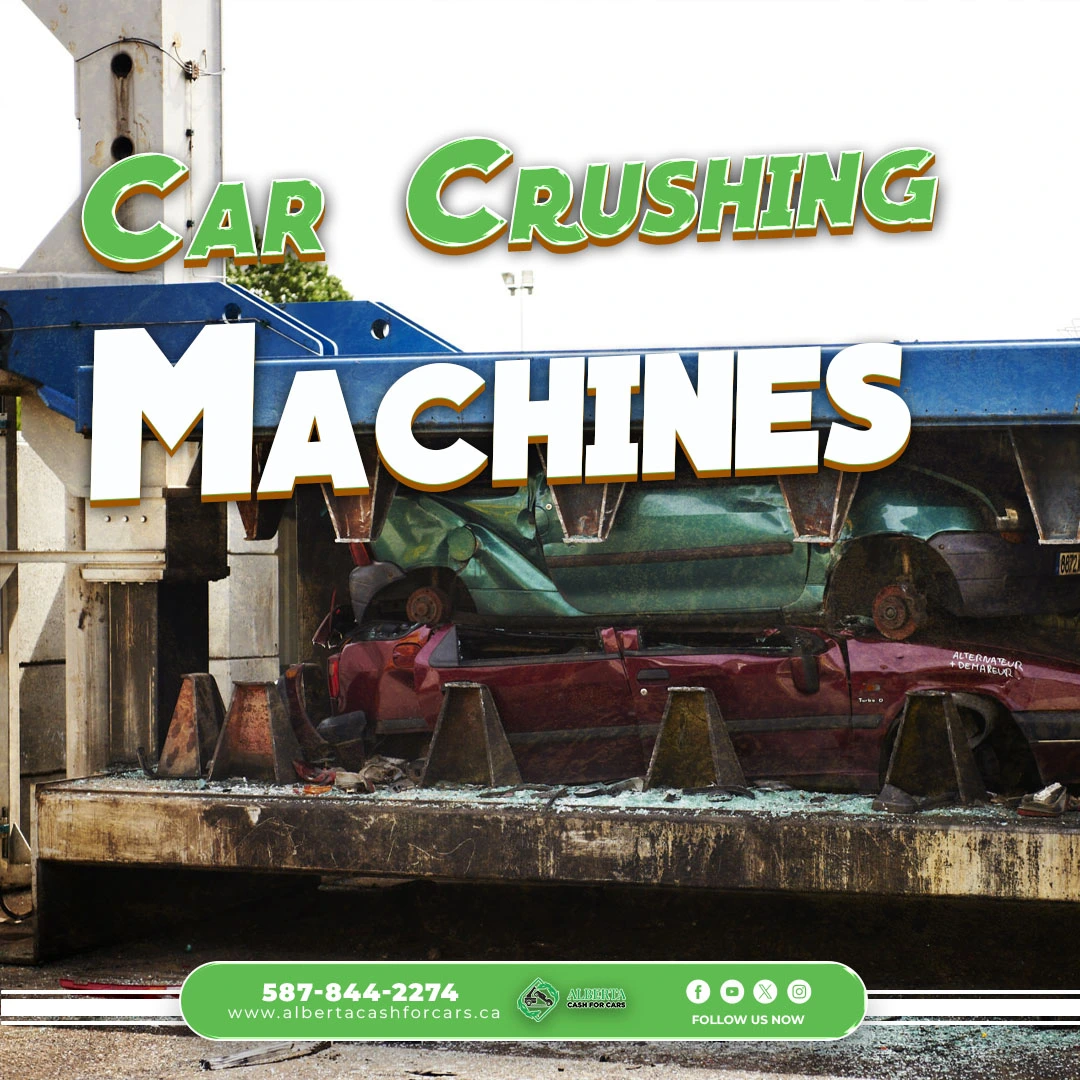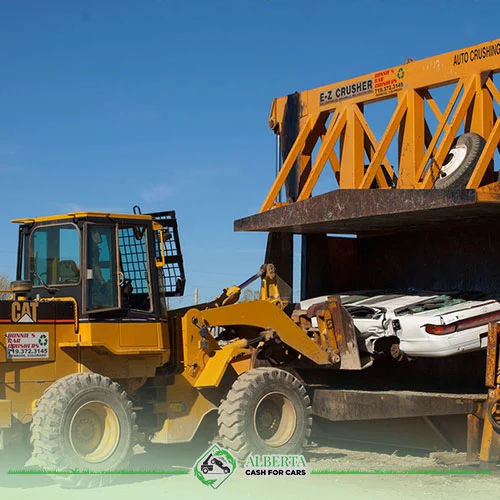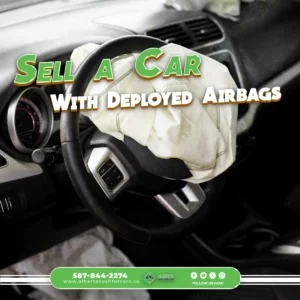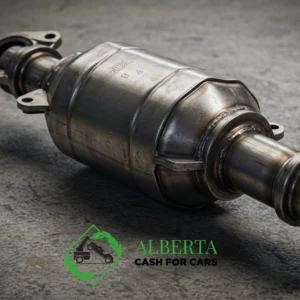Car crushing machines are vital assets in the automated dismantling and material recovery process associated with end-of-life vehicles. As aging cars contain steel and other metal components that can be recycled and repurposed, efficient mechanical equipment to compress and flatten vehicles allows for maximizing scrap metal reclamation rates. Car crushing facilities and scrap metal yards use varied high-powered machines to enable responsible car disposal and sustainability.
This blog of cash for Auto Alberta will provide a detailed overview of the crushing mechanism, primary equipment types and models, operating principles and key components, infrastructure and site considerations, cost-benefit analysis as well as emerging trends surrounding these ubiquitous industrial recycling machines.
No Hassle, Just Cash — Book Your Free Pickup or Quote Today!
Background and Benefits
Environmental benefits of auto salvage yards are increased over years. Globally around 50 million aging vehicles reach end-of-life annually. Manual dismantling poses massive environmental hazards via toxic fluid leakage, soil contamination, and unsafe practices. Using mechanical crushing and shredding systems instead enables responsible recovery under containment conditions. The compacted car bodies require 90% less storage space in landfills as well. Reselling salvaged metals generates revenues too.
Modern electric, hydraulic, and pneumatic car crushing designs compress vehicles to as low as 25% of the original volume. This allows efficient stacking and transport of flattened frames to partner separation facilities for metal recovery via spectrographic sorting, shearing, baling, etc. 85% of a car’s components contain recyclable steel metals ultimately usable across various industries after reprocessing.
Types of Car Crushing Machines System
Car crushing machines are heavy-duty robust machines customized to compress vehicles to maximized densities within integrated metal recovery circuits. The following are the main equipment types used:
Pancake Crushers
Often weighing over 75 tons themselves, these utilize two counteracting hydraulic cylinders powered by high-pressure pumps to provide crushing force. The hydraulic arms H-beam or solid compression plates exert over 2000 psi pressure flattening cars into square metal pancakes.
Shear Crushers
Such crushers use dual opposing hydraulic motors with hardened steel blades engineered to cut metal cleanly like scissors. The slicing action segments vehicle components for easier subsequent separation. bisecting cuts are applied multiple times to achieve compact cubic chunks.
Mobile Car Crushers
These portable car crushing machines powered by electric engines allow small scrapyard operators and auto salvage businesses to dismantle vehicles on-site versus outsourced processing. While throughput is lower, mobility enables cost savings.
High-Powered Crushers
Heavy-duty mega car crushers utilized large steel plates, superior hydraulic cylinders, high flow pumps, and advanced programmable automation to exert over 5000 psi for maximum vehicle compaction of even large trucks or farm equipment. The mammoth compression ratio minimizes transportation costs to recycling facilities.
Crushing Mechanisms and Process Workflow
The process of scrapping a car features integrated mechanical systems for material handling, vehicle loading, pumping, compacting/cutting, and sorting. The following are the key phases:
- Waste cars are loaded into the crushing chamber pit via an overhead crane or conveyor where fluids are initially drained.
- A sub-compression cycle ruptures embedded fuel tanks, gearbox oils, etc.
- The main high-pressure compression rapidly flattens vehicles into small, stackable ‘pancakes’.
- Hydraulically powered shearing blades may bisect flattened cars further depending on equipment type.
- Electromagnets separate metallic components from residue materials like plastics, glass, etc.
- An inclined discharge conveyor removes compressed waste.
Equipment Components and Operating Principles
To generate extreme pressures for crushing car bodies into high-density blocks, various robust interconnected components make up crushing machines:
Hardened Steel Frame
The base frame and compression brackets comprise thick structural steel for rigidity under continuous pounding loads. Reinforced floors enable equipment movement. The chamber walls prevent debris from spraying out.
Hydraulic Power Pack
High capacity pumps, large custom cylinders, high pressure hoses, and valves generate over 2000 psi oil pressure converted into vertical plate force via leverage principles of fluid power transmission.
Compression Plates/Blades
These thick reinforced steel sections cut/compress vehicles into small chunks. Different profiles allow custom force distribution. Wear-resistant alloys prevent fatigue issues over prolonged use.
Programmable Automation
PLC hardware coupled with HMI touchscreens allows configuring bespoke crushing cycles, force modulation, and metal sorting parameters. Safety interlocks prevent accidents.
Instrumentation & Sensors
Proximity sensors track position and pressure transducers provide feedback on optimal functioning. Temperature and fluid gauges are vital as well.
Safety First: Operating Car Crushing Machines Responsibly
Car crushing machines are incredibly powerful, and safety must be a top priority for anyone working with them. Mishaps can lead to serious injuries or even fatalities, so understanding and adhering to strict safety protocols is non-negotiable.
Comprehensive Training: Knowledge is Your Best Defense
All operators and maintenance personnel should undergo thorough training on the specific crushing machine they’ll be working with. This includes understanding the machine’s operating principles, safety features, and emergency procedures. Regular refresher training is also essential to reinforce safety practices and keep everyone up-to-date on the latest safety guidelines.
Personal Protective Equipment (PPE): Gear Up for Safety
Wearing the appropriate PPE is crucial. This includes:
- Hard hats: To protect against falling debris.
- Safety glasses: To shield eyes from metal fragments and other projectiles.
- Hearing protection: To minimize exposure to loud noises.
- Steel-toed boots: To protect feet from heavy objects.
- High-visibility clothing: To ensure operators are easily seen.
Lockout/Tagout Procedures: Preventing Accidental Activation
Before performing any maintenance or repairs, always follow lockout/tagout procedures. This involves disconnecting the machine’s power source and securing it with locks and tags to prevent accidental activation.
Regular Inspections and Maintenance: Keeping Machines in Top Shape
Regular inspections and maintenance are essential to ensure the crushing machine is operating safely. Check for wear and tear on hydraulic hoses, cylinders, and other components. Address any issues promptly to prevent breakdowns and potential accidents.
Emergency Stop Procedures: Knowing When to Halt
All operators should be familiar with the emergency stop procedures and know how to quickly shut down the machine in case of an emergency. Clearly marked emergency stop buttons should be easily accessible.
Controlled Access: Limiting Exposure
Restrict access to the crushing machine’s operating area to authorized personnel only. This minimizes the risk of unauthorized individuals entering the danger zone.
Environmental Considerations: Containing Hazards
Car crushing operations can release hazardous fluids and materials. Implement proper containment measures to prevent environmental contamination. This includes proper drainage systems and spill containment equipment.
Design Customization Factors
Car crushing machines plants are customized to desired functionality levels based on key considerations:
Tonnage Ratings
Higher capacity pumps, larger cylinders, and robust platens allow consistently crushing even 40-ton vehicles. Throughput rate requirements determine overall equipment size.
Compression Ratios
Maximizing scrap metal densities saves transport and processing costs later. Compression ratios of up to 5000:1 flatten cars to fractions of the original volume.
Automation Levels
While manual valve operation allows basic crushing, sensor-driven automation enables optimizing functionality. Programmable PLCs also facilitate data-driven process improvements and predictive maintenance.
Latest Advances and Applications
Car crushing and recycling are now mainstreamed globally across material recovery ecosystems. Innovations in the domain span:
- Electric Power: Transitioning hydraulics to efficient electric drives lowers running costs and emissions. Though the initial compression force is lower, rapid cycling allows parity.
- Augmented Analytics: Connecting crushing plant data to cloud IoT platforms enables predictive maintenance via machine learning models trained on equipment parameters.
- Metal Sorting: Advanced spectrographic sensors matched with robotic sorting arms separate aluminum, steel, iron, and copper automatically post-crushing to simplify recycling channeling.
- Secure Data Services: Special on-site document shredding machinery integrated with car crushers ensures foolproof information destruction for government agencies and corporations.
The automobile recycling industry is expected to touch a $140 billion valuation by 2030 as urbanization and automotive growth accelerates waste generation. Car crushing thus constitutes a vital sustainability-centric industry.
The Environmental Footprint of Car Crushing: A Deeper Look
While essential for recycling end-of-life vehicles, car crushing, performed by powerful machinery, has environmental impacts beyond just landfill diversion. Although contributing to a circular economy, the process presents challenges requiring mitigation. The car crushing machine itself significantly influences the environmental burden.
Here’s a breakdown of key footprint aspects:
- Energy Consumption: Car crushing machines, especially older hydraulic models, are energy-intensive. The electricity source (fossil fuels vs. renewables) heavily impacts the carbon footprint. Choosing energy-efficient models and optimizing operations are vital.
- Noise Pollution: The powerful forces of a car crushing machine create loud impacts. This affects nearby communities and wildlife. Sound barriers, enclosed facilities, and strategic site location are crucial mitigation methods.
- Air Quality (Dust/Particulates): Modern car crushing machines often have dust suppression, but older equipment can pollute. Proper filtration and adherence to regulations are essential.
- Hazardous Fluid Management: Vehicles contain hazardous fluids (oil, coolant, etc.). Before a vehicle reaches the car crushing machine, these must be drained and disposed of properly to prevent soil and water contamination. Strict adherence to protocols is paramount.
- Land Use: Facilities require land. Location and design should minimize habitat disruption.
- Transport and Manufacturing: Consider the fuel of transporting vehicles and the impact of car crushing machine production.
This deeper look highlights the need for a holistic approach, emphasizing responsible practices and advancements to minimize environmental impact. Continuous improvement is vital for sustainable car recycling.
Conclusion
As ecological consciousness around circular economies spreads, car crushing machines hold immense potential to support responsible vehicle end-of-life practices via volume reduction and scrap metal reclamation. Heavy-duty specialty hydraulic and pneumatic machines designed to exert extreme compressive forces flatten aging automotive to a fraction of their original size. This allows for maximizing transportation densities and subsequent recycling profitability.
With integrated automation, high-powered crushing equipment enables safe, swift vehicle dismantling. Continuous innovations around connected analytics, electric drives, and metal sorting herald an emerging smart waste processing infrastructure. Overall, car crushing delivers essential volume reduction and materials recovery services enabling communities to extract value from used commodities in an eco-friendly manner.









